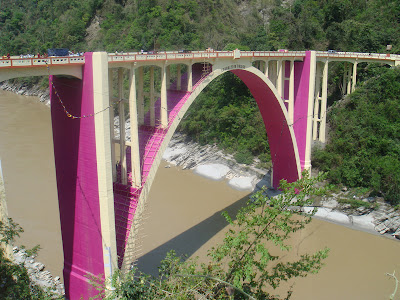P
 |
| The rooms are to the right and the public areas to the left, both fronting the pool at Oberoi Gurgaon |
It’s been awaited with bated breath. The Oberoi Gurgaon, in
the making for a number of years, has finally thrown up its steel and glass
frame. Given that the group has made a city hotel after a gap of nearly two
decades, the anticipation, and secrecy, about the project had been high.
For those familiar with its sister brand’s hotel, the
Trident Gurgaon, with domed architecture, lush picture-perfect gardens and
adjoining water bodies, its new neighbour, The Oberoi is as unlike it as it
could be.
The challenge was to do up the Oberoi as differently as possible
from its existing flagship hotel in Delhi .
The Oberoi Gurgaon, built at an estimated cost of Rs 400 crore over nine acres,
has been imaginatively conceptualised and painstakingly built from scratch,
largely by the in-house team led by PRS Oberoi, Chairman of the EIH group,
arguably India’s top end luxury hospitality chain and RSP Architects. The group
is on an expansion spree, and is adding five new properties to its existing 32.
The new hotel, which is on a management contract for the
group, has spared little to make itself a destination of choice for NCR’s
elite. It opted for a clean look, prepared a freshly built hill topped by a
forest, a vertical green wall, and a lobby at the top of the hotel. The hill,
built on flat land, took about five years to complete, and trees were planted
atop that with enough depth to ensure that no one can reach the massive 36,000
ft2 cobalt blue tiled pool in middle. Shades of blue, soft in most parts, with
a touch of vibrancy here and there, surprise you as wander around the property.
The hill also leads to the lobby, placed a la a property in hills, at the top
level of the five-floor hotel. The retail section at the entrance is yet to
come up, but will have brands such as Bottega Veneta and Jimmy Choo. The way up
to the lobby will have the choicest of global luxury brands besides the
Oberoi’s patisserie and deli.
Another F&B highlight is an extension of the Oberoi
Delhi’s popular all day dining outlet, 360º. Only, Gurgaon goes several notches
higher in its threesixtyoneº - which at about 10,500 ft2 is the largest of its
kind in the country. It has three distinct sections – one each for Japanese,
Italian and a combined Chinese and Indian. Even with its greatly spacious
seating, it can accommodate 202, and being on the pool front, offers a
spectacular view on nightfall. It even
has a poolside, but its prospective popularity, chances are slim that you will
get seating there easily! There is also another fine dining restaurant, Amaranta,
an Indian seafood restaurant. It has a live crabs and other sea food on offer,
including the blue Saurashtra crab, fresh caught! In fact fresh catch comes in
from Kochi ,
Chennai and Vizag every morning, even if the sea is a thousand miles away.
The hotel has, perhaps deliberately, not created a huge
inventory of rooms, especially given the fact that there are luxury hotels
already in the proximity, and many more in the offing. The smallest of the 202
rooms however measures a goodly 620 ft2, while the suites range from 1,240 to
5,300 ft2. Yes, the largest three have private pools, cantilevered outdoor
heated pool deck. Yes, living experience justifies its cost. The hotel is all
about experiential luxury. ‘Height, light and space’ are the three magic words
he uses as he proudly points out the special features of the property. Which
includes what the hotel claims as the largest green wall anywhere in the world,
about 10,000 ft2. But the smallest, ‘deluxe’ rooms have all the amenities from
electronic safes to I-pod docking stations and media hubs.
The hotel has all the facilities of a top end business
hotel, with large meeting and banqueting facilities, with a separate entrance
of its own. Did I forget to mention the Piano bar or the Cigar Lounge or the
butlers trained by the Guild of Professional English Butlers, the first
Rossanno Ferretti salon in the country, the 150-odd black and white photographs
of leading Indian monuments and numerous paintings by emerging Indian artists
or the 24 hour spa or the 18,000 of conference facilities or an art gallery by
Nature Morte? Take out some time when you come to explore NCR’s latest and last
word in hospitality till date.



